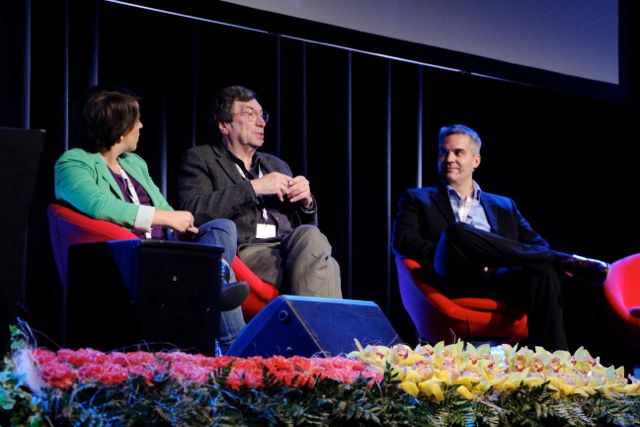
Photo: Wendy Zhou
Mar Cabara, David Leigh and Oliver Zihlmann talking about their Swissleaks discoveries
Timelines, local knowledge and a flash drive: the layers of the Swiss Leaks story.
The Swiss Leaks investigation was more difficult to prove than Oliver Zihlmann, head of the investigative team in Le Matin Dimanche and SonntagsZeintung in Switzerland, first thought.
In most cases, he explained, the HSBC probably did not know that they were working with criminals, due to the fact that many of the bank accounts were opened prior to convictions. With the use of timelines, however, they were able to connect the money with the people, the accounts and the companies.
The Flash Drive
“It all started with a flash drive,” Mar Cabra, the data editor at the International Consortium of Investigative Journalists (ICIJ) told the auditorium.
The flash drive contained excel sheets of all the clients of the Swiss subsidiary of HSBC. A Swiss banker shared the drive with journalists at the French newspaper Le Monde, who shared it with journalists at ICIJ who subsequently built a searchable database. “It looks like our own private Facebook,” Cabra said.
She claims it is the biggest cross-border investigation so far, with 160 reporters from 50 countries and 63 different media-outlets connected to the story. All of them could see the data.
“We did a better job than the tax-authorities. We let all the countries see everything,” Cabra explained. “That way, those trying to hide behind offshore companies were also exposed.”
The collaboration with local reporters, David Leigh from The Guardian explained, was key for connecting names to companies and accounts.
Criminal bank or just criminal clients?
Zihlmann was determined to prove the bank was laundering money for its clients, and with his timelines he realized that HBSC should have known that when Emmanuel Shallop opened his accounts, he was trafficking blood diamonds for Sierra Leone. The bank admitted to organizational failures for which they paid a fine of 40 million Swiss francs.
Leigh discovered that HSBC helped their clients set up offshore companies to hide their money, and found British “Nom-doms,” people with a link to a foreign country and the ability to store all their money abroad.
Using the lists, the journalists made a “cash railway” to identify who traveled to Switzerland to withdraw large sums of money in a foreign currency. From there, they were able to link those people to offshore companies used to hide the money.
“We had a meeting with the lawyers and the HSBC public relations representative, they threatened harsh legal actions if we published the story,” Leigh said.
If The Guardian did not publish the names, however, the journalists knew another publication would. To avoid getting scooped, the newspaper gave the bank an opportunity to provide a statement and were able to publish their findings free from legal ramifications.
The authors are journalism students at the University College of Volda who are on special assignment covering #gijc15.
